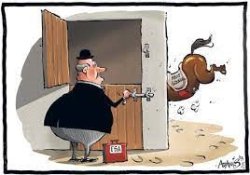
All News
Daily Bridge in New Zealand

It’s Too Late: For Less Experienced Players and others.
It is far too late when half way through the play of a board a declarer realises that they just do not have enough tricks to make their contract. That lack of planning would prove their downfall. That’s right. Counting your tricks at the first sight of dummy would have been a great idea.


| East Deals None Vul |
|
||||||||||||||
|
|
|
|
|||||||||||||
|
|||||||||||||||
| West | North | East | South |
| 1 ♣ | 1 ♦ | ||
| Dbl | 1 ♠ | 2 ♣ | 2 ♦ |
| Pass | 3 ♦ | Pass | 5 ♦ |
| All pass |
The bidding was competitive but North-South reached a reasonable game contract. West led ![]() 6. Plan the play.
6. Plan the play.
What happened
Declarer won the opening lead and drew the opponents’ trumps. With West starting with an original three, that meant South was left with one trump in dummy and two in their own hand, three trump tricks along with the three they had already won. They had two certain heart tricks and the ![]() A. That came to 9 with the only chance of any more if the
A. That came to 9 with the only chance of any more if the ![]() K and
K and ![]() J fell in the first three rounds to produce two extra tricks. They did not. Down two and very soon the realisation that computer software said that 11 tricks were achievable.
J fell in the first three rounds to produce two extra tricks. They did not. Down two and very soon the realisation that computer software said that 11 tricks were achievable. ![]()
What should have happened
That trick count should have happened at the first sight of dummy. You cannot draw the opponents’ trumps if there is some ruffing in one or both hands to be done unless you have plenty of trumps, which was not the case here. When both sides try to draw trumps, one of them is usually wrong!
The trump lead was annoying for declarer and good for the defence. South needed to cash ![]() A at trick 2 and then lead a heart towards dummy. West might think they were onto a good thing and take their
A at trick 2 and then lead a heart towards dummy. West might think they were onto a good thing and take their ![]() A to lead a second round of diamonds(
A to lead a second round of diamonds(![]() 6) though South would prevail even if West ducked:
6) though South would prevail even if West ducked:
| East Deals None Vul |
|
||||||||||||||||||||||||||||||
|
|
|
|||||||||||||||||||||||||||||
|
|||||||||||||||||||||||||||||||
| West | North | East | South |
| 1 ♣ | 1 ♦ | ||
| Dbl | 1 ♠ | 2 ♣ | 2 ♦ |
| Pass | 3 ♦ | Pass | 5 ♦ |
| All pass |
Needing entries to dummy, South should take a free finesse of ![]() 10 by inserting
10 by inserting ![]() 8 with East making a huge signal for a club switch. Now, ruff a spade and play a heart to the jack. Ruff a second spade and play a heart to the king. Ruff a third spade with South’s last remaining trump and these cards will remain:
8 with East making a huge signal for a club switch. Now, ruff a spade and play a heart to the jack. Ruff a second spade and play a heart to the king. Ruff a third spade with South’s last remaining trump and these cards will remain:
|
|||||||||||||||||||||||||||||||
|
|
|
|||||||||||||||||||||||||||||
|
|||||||||||||||||||||||||||||||
Declarer plays a club and the defence is helpless. West can win and play either non-trump allowing declarer to ruff in dummy, draw trump and play the established ![]() Q at trick 13.
Q at trick 13.
Had the defence started with two rounds of clubs, South could ruff, play a spade to the ace and ruff a second club. Then, spade ruff and a third club ruff before drawing trumps and losing a trick to the ![]() A. That’s effectively 5 trumps in their own hand, three club ruffs in dummy, two hearts and the SA: again 11 tricks.
A. That’s effectively 5 trumps in their own hand, three club ruffs in dummy, two hearts and the SA: again 11 tricks.
Declarer’s line may differ according to how the opposition defend. The one line South must not take is to draw trumps. When the break is 3-1 or worse or when the ![]() K is in a 4-card suit, drawing trumps will lead to the defeat of the contract and no “smiley face” for the declarer!
K is in a 4-card suit, drawing trumps will lead to the defeat of the contract and no “smiley face” for the declarer!

Hopefully not you!
Where to go?
|
| West | North | East | South |
| Pass | 1 ♣ | 1 ♠ | 2 ♦ |
| Pass | 2 ♥ | Pass | 2 ♠ |
| Pass | ? |
1![]() is 3+ clubs and you are playing Pairs. Do you agree with the 2
is 3+ clubs and you are playing Pairs. Do you agree with the 2![]() bid above? What now?
bid above? What now?
Richard Solomon
Go Back View All News Items
